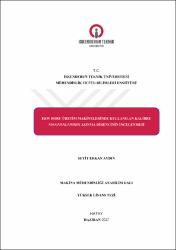| dc.contributor.advisor | Yapıcı, Ahmet | |
| dc.contributor.author | Aydın, Seyit Erkan | |
| dc.date.accessioned | 2020-12-24T08:19:41Z | |
| dc.date.available | 2020-12-24T08:19:41Z | |
| dc.date.issued | 2017 | en_US |
| dc.date.submitted | 2017 | |
| dc.identifier.citation | Aydın, S. E. (2017). ERW boru üretim makinelerinde kullanılan kalibre makaralarının aşınma direncinin incelenmesi. (Yüksek Lisans Tezi). İskenderun Teknik Üniversitesi / Mühendislik ve Fen Bilimleri Enstitüsü, Hatay. | en_US |
| dc.identifier.uri | https://hdl.handle.net/20.500.12508/1550 | |
| dc.description.abstract | Bu çalışmada, dikişli boru makineleri kalibre makaralarında kullanılan DIN 1.2379 soğuk iş takım çeliğine farklı sıcaklık ve sürelerde yapılan borlama işleminin aşınma direnci üzerine etkisi incelenmiştir. Borlama işlemi Ekabor-II tozu ile gerçekleştirilmiş olup, farklı iki parametrede denenmiştir. Parametre değişkenleri, sıcaklık ve süre olarak ele alınmıştır. Seçilen sıcaklık değerleri; 900 ºC ve 1000 ºC olup, her bir numune bu sıcaklıklarda 3-5-7 saat borlama işlemine tabi tutulmuştur. Borlanmış numunelerin, metalografik incelemeleri optik, SEM, EDS, XRD analizleri ile, mekanik özellikleri ise mikrosertlik ve aşınma testleri vasıtasıyla gerçekleştirilmiştir. Borlama işlemi sonucunda yüzeyde borür tabakasının yanında geçiş bölgesinde ikincil karbür fazların meydana geldiği tespit edilmiştir. Borür tabakası kalınlığı, geçiş bölgesi ve kaplama tabakası sertliğinin artan borlama süresi ve borlama sıcaklığı ile arttığı tespit edilmiştir. Metalografik incelemeler sonucunda borlama şartlarına bağlı olarak 2005-2227 HV 0,1 sertlik değerlerine ve 46,23-126,8 µm borür tabakası kalınlığına sahip borür tabakaları elde edilmiştir. XRD analizleri sonucunda borlanmış numunelerde FeB ve Fe2B fazının baskın fazlar olduğu tespit edilmiştir. Kaplama tabakalarındaki sertlik artışının, aşınma direnci üzerine olumlu etkisi olduğu saptanmıştır. Kaplanan numunelerde optimum sertlik ve aşınma direnci, 1000 ºC'de 7 saat borlanan numunede gözlemlenmiştir. Borlama işlemi sonucunda elde edilen aşınma dirençleri hem ticari DIN 1.2379 çeliği hem de mevcut endüstriyel uygulamaarda kullanılan kriyojenik işleme tabi tutulan makaralara göre daha iyi aşınma dirençleri elde edilmiştir. Aşınma miktarı incelendiğinde işlemsiz, kriyojenik işleme tabi tutulan ve borlanmış numunelerde uygulanan 10, 20, 30 N 'luk kuvvetler sonucunda, yük artışı ile beraber aşınma miktarının arttığı gözlemlenmiştir. Aşınma oranları işlemsiz numunede 10, 20 ve 30 N için sırasıyla 5,7 x10¯5, 10,8 x10¯5, 17,43 x10¯5 mm3/Nm , kriyojenik işlem görmüş numunede 4,56 x10¯5, 8,33 x10¯5, 12,02 x10¯5, borlanmış numunede ise 1,69 x10¯5, 2,19 x10¯5, 2,6 x10¯5 mm3/Nm tespit edilmiştir. | en_US |
| dc.description.abstract | In this study, caliber roller 1.2379 cold work tool steel which is used in the welded pipe machines was used to examine the effect of the boriding treatment at different temperature and time upon the abrasion resistance. Boriding process is made by Ekabor-II powder and tested at two different parameters. The chosen temperatures are 900 ᴼC and 1000 ᴼC and samples were waited for 3-5-7 hours. Metallographic examination of the boronized samples were tested by optical, SEM, EDS, XRD, microhardness and subjected to abrasion testing. Boriding the surface as a result of the transition region together with boride layer was found to occur secondary carbide phase. The layer thickness of the transition region and the coating layer were observed to increase in proportion to the duration of stiffness. As a result of metallographic examinations, depending on the boriding conditions 2005-2227 HV hardness of 0.1 µm, and from 46.23 to 126.8 boride layer tube having the layer thickness are obtained. XRD analysis were identified as the dominant phase in the samples of FeB and Fe2B. The increase in the hardness of the coating layer was found to have a positive effect on the wear resistance. Optimum hardness and abrasion resistance of the coated samples was observed in condition which is boriding for 7 hours at 1000 ºC temperature. The wear resistance is obtained as a result of boriding, commercial AISI D2 steel is better than both rollers subjected cryogenic processing. When the wear amount is analyzed, as a result of forces applied 10,20,30 N to the sample, it is observed that load increase was observed with an increased amount of wear. Wear rate of the untreated sample one by one for 10 , 20 , 30 N : 5,7 x10¯5, 10,8 x10¯5, 17,43x 10-5 mm3/Nm , for cryogenic treated sample : 4,56 x10¯5, 8,33 x10¯5, 12,02 x10¯5, and for borided sample : 1,69 x10¯5, 2,19 x10¯5, 2,6 x10¯5 mm3/Nm. | en_US |
| dc.language.iso | tur | en_US |
| dc.publisher | İskenderun Teknik Üniversitesi / Mühendislik ve Fen Bilimleri Enstitüsü / Makine Mühendisliği Anabilim Dalı | en_US |
| dc.rights | info:eu-repo/semantics/openAccess | en_US |
| dc.subject | DIN 1.2379 soğuk iş takım çeliği | en_US |
| dc.subject | Bor kaplama | en_US |
| dc.subject | Kalibre makaraları | en_US |
| dc.subject | 1.2379 cold work tool steel | en_US |
| dc.subject | Boron covering | en_US |
| dc.subject | Caliber rollers | en_US |
| dc.title | ERW boru üretim makinelerinde kullanılan kalibre makaralarının aşınma direncinin incelenmesi | en_US |
| dc.title.alternative | Examination of wear resistance of caliber rollers that are used in the ERW pipe manufacturing machines | en_US |
| dc.type | masterThesis | en_US |
| dc.contributor.department | Mühendislik ve Fen Bilimleri Enstitüsü | en_US |
| dc.relation.publicationcategory | Tez | en_US |
| dc.contributor.isteauthor | Yapıcı, Ahmet | |
| dc.relation.index | İndeks Bilgisi Yok | en_US |
















